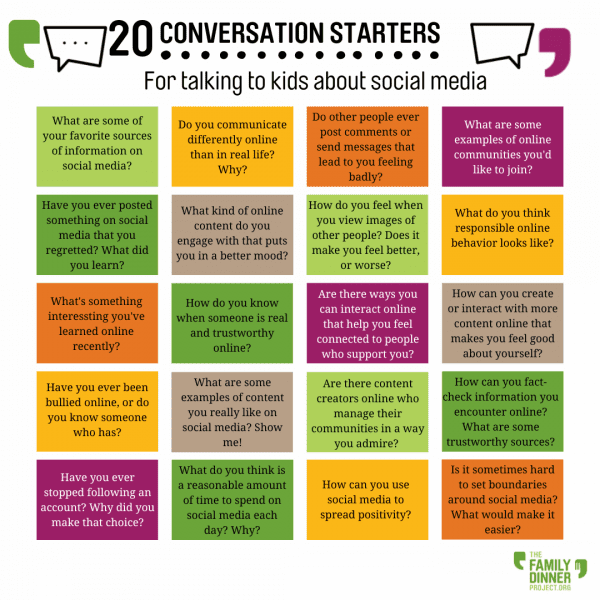Newsletter: May 2023
Talking to Kids About Technology

“People call me an old man, but I guess I just don’t get it,” my 16-year-old son said. “What’s the point of just taking a bunch of selfies and sending them to people?”
He’d recently added Snapchat to his phone after years of resisting his friends’ pleas, and as he compared it to his other social media accounts – Facebook, Twitter, Instagram, and BeReal – he was increasingly confused about the way other kids chose to interact on each platform. “The filters aren’t a great idea either,” he told me. “I feel like nobody looks the way they look in real life, so it’s like a big competition to look the best on social, but then nobody’s happy and they’re chasing something fake anyway.”
I usually listen and nod and try to ask good questions, while silently counting myself lucky that we’ve so far been largely unaffected by some of the social media challenges many families face. This particular child of mine has had a few little missteps over the years, but he’s got a good head on his shoulders and remarkably good self-control when it comes to spending time and energy online. His younger brother, about to enter high school, has so far refused to get any kind of social media accounts, calling them “a stupid waste of time for insecure people.” But that doesn’t mean tech troubles are totally out of the picture for us. I could easily tell stories about the dramatic arguments we’ve had after setting limits on video games, virtual reality, and YouTube consumption – and that’s just for starters.
While every family will have different boundaries and limits on technology, there are good reasons for parents to be concerned about how our kids interact online. When I was researching our recent content about family dinner and eating disorders, the experts I spoke to expressed worry over the negative impact social media can have, especially on body image and disordered behaviors. Dr. Jennifer Goetz, speaking about teens she’s worked with in eating disorder recovery, said: “I often work with kids, teens, and families to disengage from social media by using a motivational interview approach to how it affects the individual on a day-to-day basis. I have yet to have someone disengage from social media who regrets it. For parents who are concerned about what their children may be consuming, the best bet is to talk directly to them.”
Social comparison – both body-focused and otherwise – is also a concern for Dr. Neha Chaudhury. She lists it alongside cyberbullying and dark, negative content as a reason for parents to be vigilant about what their kids are encountering online. But technology is here to stay, and our kids are living in an increasingly online world. What can parents do, and how should we be talking about tech to impart the judgment and digital citizenship values we want our kids to adopt? And how do we learn from them about the things they value in the virtual world, which we may not understand?
- Set the stage for communication. Although this article was written during re-entry from the COVID pandemic, the advice from Drs. Julianna Chen and Tai Katzenstein can apply to almost any parenting situation. They recommend being calm, compassionate, concerned, and curious when approaching kids about tough topics – and they have some surprising insights into how technology could be the gateway to better parent-child communication.
- Examine all angles. Dr. Neha Chaudhury is well-acquainted with the downsides of the internet, but she’s also practical about the upsides – and she wants parents to be aware of them, too. “Despite the many risks, there are also many advantages to social media that get overlooked,” she says. In talking with your kids about tech use, showing that you understand both sides of the equation can open up a more productive conversation. Dr. Chaudhury offers lots of questions you can ask to start the discussion.
- Demonstrate a willingness to listen. Recently, in a tense discussion with one of my sons about a “mature” rated game he wanted to play, I stepped back and thought about who might know more about the game and its contents: the parents generating reviews on a well-known media ratings site, or young men who play the game and discuss it in an online forum? I decided to read more perspectives from teens and young adults who knew the game intimately. I was surprised to learn that there were deep discussions about workarounds that allowed users to turn off some of the more concerning content in the game, and lots of teens chatting about why they chose to adopt those settings. While it didn’t change my ultimate decision about letting my son have the game right now, showing him their discussions about the graphic content helped him recognize that my concerns about the game weren’t just coming from a “parent” point of view. As a bonus, we found recommendations in that thread for similar, but less gory, games that we could agree were appropriate for him.
- Find ways to use tech together positively. While banishing technology from family time altogether is tempting – and can be useful in some situations – it’s also possible to find a happy compromise. Our Technology at the Table page shares ideas for games and activities you can use that promote bonding and connection with digital devices, so you can work together to find a balance that’s right for your family.
Food

At this time of year, the calendar might be packed with end-of-school-year events. These freezer-friendly panini can save your family dinner on busy nights!
Fun

Let technology play a part with a round of Google Feud!
Conversation
It can be hard to know where to start with conversations about social media and interacting online. Here are 20 questions to help you get the ball rolling.

Recent Newsletters
- When Picky Eating Might Be Something More - July 2024
- Feeling Lonely? Share a Meal. - June 2024
- Welcome to May Madness - May 2024
- Family Dinner Has Gotten Expensive - April 2024
- Is it the Family, Or the Dinner? - March 2024
- Black History Month at Family Dinner - February 2024
- New Year, Same You - January 2024
- Sharing the Holiday Load - December 2023
- What’s Your Thanksgiving Story? - November 2023
- Family Dinner: Stressful, or Stress-Busting? - October 2023
- New Ways to Ask “How Was Your Day?” - September 2023
- Low Stress, Low Cost, Low Waste Dinner Hacks - August 2023
